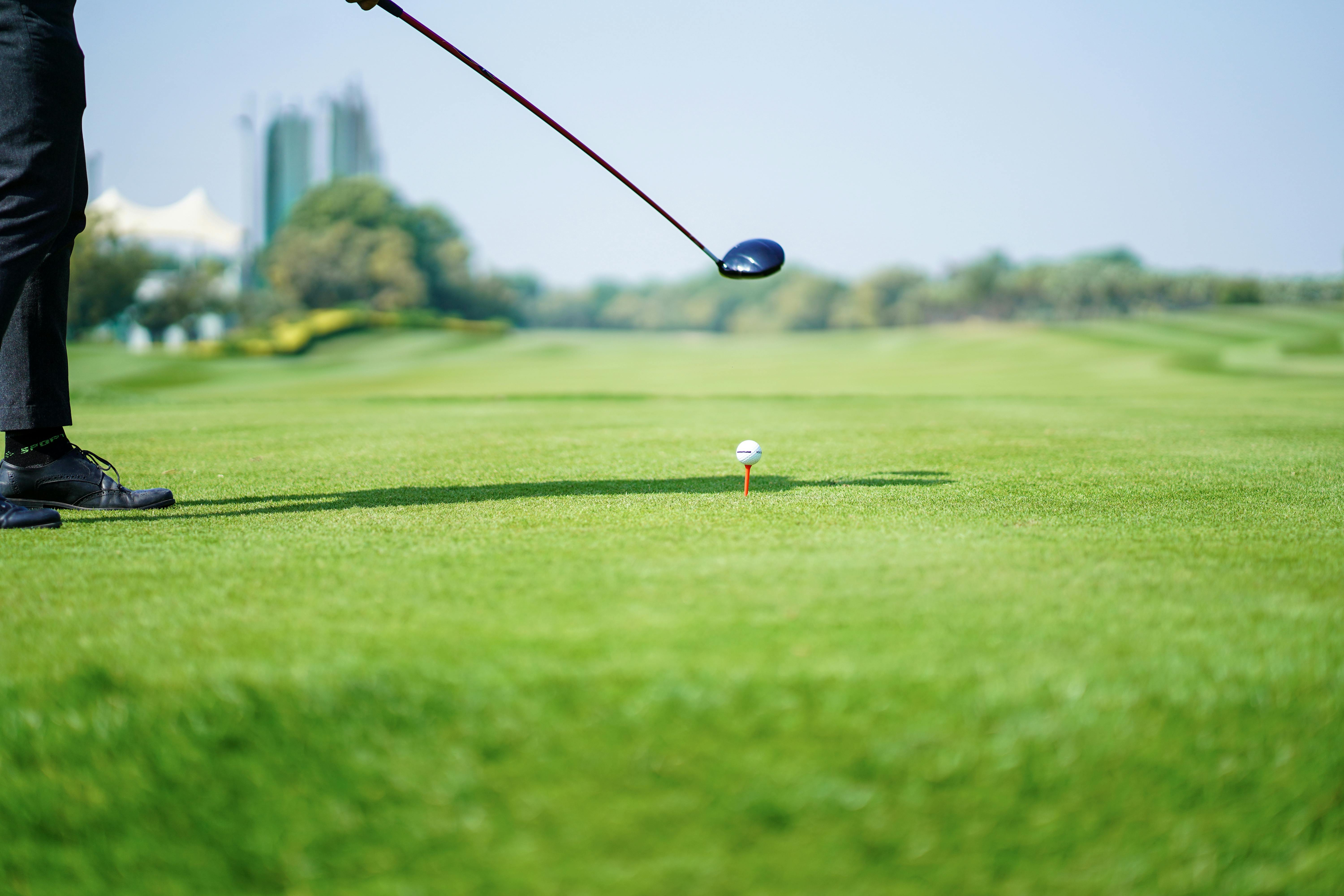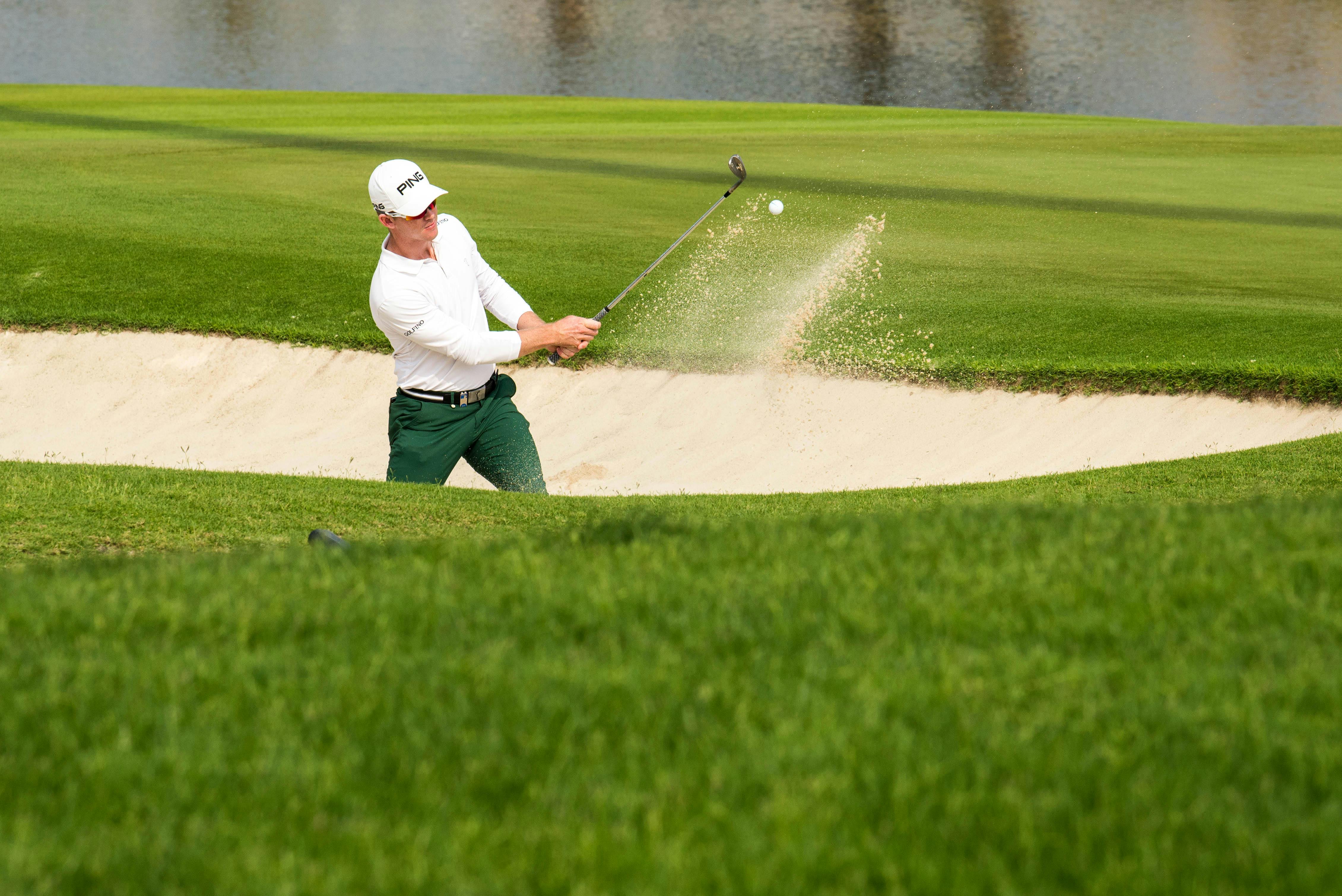Hitting down on a golf ball is an important skill to learn if you want to maximize your distance and accuracy. When done correctly, a golfer can hit down on the golf ball and create a much lower trajectory than what they would normally get from a normal shot. This technique requires practice, as it is not something that can be picked up overnight. In this article, we will discuss how to hit down on a golf ball and the various techniques you can use to achieve this goal.To properly execute a downswing in golf, begin by setting up with your feet shoulder-width apart. Turn your hips and shoulders towards the target while maintaining your spine angle. Shift your weight to the front foot as you begin to swing. Keep your arms and hands relaxed and your wrists in hinge position as you bring the club back down on an inside path. Finish with a full shoulder turn, keeping the head still, and complete the swing by extending through impact and releasing the club through the ball.
Understanding the Fundamentals of Hitting Down on a Golf Ball
Hitting down on a golf ball is an important skill to master if you want to have consistent success on the course. Knowing when and how to hit down on the ball can help you hit more consistent shots and get better distances. To do this, you need to understand the fundamentals of hitting down, which includes proper club selection, body posture, and swing mechanics.
The first step in understanding how to hit down on a golf ball is choosing the right club. Generally speaking, it is best to use a lower-lofted club like an 8 or 9 iron when hitting down on a golf ball. This will allow you to get more control over the shot and keep it low enough so it won’t fly too far.
Your body posture is also important when hitting down on a golf ball. You should stand with your feet slightly wider than shoulder-width apart and bend from your knees and hips rather than your waist. This will help keep your weight centered over the ball and ensure that you are in proper balance throughout the swing.
Finally, proper swing mechanics are key when hitting down on a golf ball. Make sure that your arms are straight throughout the entire swing and that you don’t lift or dip your wrists as this will cause you to lose control of the shot. Also try to keep your head still during the swing so that you can maintain good eye contact with the ball.
By understanding these fundamentals of hitting down on a golf ball, you can develop better consistency in your shots and get better results out on the links. Practice these techniques regularly in order to become more comfortable with them and soon enough you’ll be able to master them just like any other skill in golf.
Preparing Your Body for a Downswing in Golf
In order to successfully execute a downswing in golf, your body must be prepared. The key to this preparation is having the correct posture and balance. This will help you maintain the right form throughout the entire swing and ensure that you get the best possible results.
The first step in preparing your body for a downswing is establishing good posture. This should involve keeping your feet shoulder-width apart and standing tall with your arms and shoulders relaxed. Make sure that your weight is evenly distributed between both feet and that you have a slight bend in your knees. Additionally, hold the club firmly but not too tightly in order to maintain control of it during your swing.
The second step of preparation involves finding the correct balance between shifting your weight forward and back during the downswing. To achieve this, start by shifting your weight onto the front foot as you begin to swing, then quickly move it back onto the rear foot once you reach the top of your backswing. You should also focus on keeping most of your weight on either foot throughout the entire swing so that you don’t lose balance or control of the club.
Finally, make sure that you keep your head still throughout the downswing so that there is no disruption to your balance or momentum. Keeping everything else steady will also help ensure a consistent motion as you complete your swing and maximize distance off of each shot.
By following these simple steps, you can prepare yourself properly for a successful downswing in golf and improve both accuracy and distance off each shot.
Mastering the Weight Transfer During a Downswing in Golf
Golf is a sport that requires a great deal of skill and technique. One of the most important aspects of the game is mastering the weight transfer during a downswing. The weight transfer is one of the elements that will determine how far and straight you can hit the ball. Learning to properly transfer your weight during a downswing can help you improve your golf performance.
The weight transfer during a downswing begins with your feet and legs. As you begin to move through your swing, you should focus on transferring your weight from your back foot to your front foot. This will help create power and control in your swing as well as help to increase distance off the tee. To ensure proper weight transfer, make sure you have good balance and keep your head over the ball throughout the swing.
Another important aspect of mastering the weight transfer during a downswing is learning how to rotate correctly through impact. During this phase of your swing, it is important to stay balanced and maintain posture throughout the entire motion. As you reach impact, make sure that all parts of your body are in sync with each other – from head to toe – so that you can create maximum power with each shot.
Finally, when learning how to master the weight transfer during a downswing, it is important to understand how gravity affects this motion. Gravity serves as an extra force when swinging, helping to create more momentum in order for you to hit longer drives and straighter shots. When swinging, focus on creating an angle between your club shaft and spine by pushing against gravity’s downward pull with each shot. Doing so will enable you to generate more power off each shot while maintaining control over ball flight.
By understanding how gravity affects each swing and learning how to properly transfer your weight throughout each motion, you will be able to master the weight transfer during a downswing in golf like never before – allowing for improved performance on every shot!
Maximizing Club Head Speed With an Appropriate Downswing in Golf
One of the most important aspects of golf is maximizing club head speed. Having a powerful and accurate swing is essential for achieving consistent results on the course. To maximize club head speed, you must focus on having an appropriate downswing. This article will discuss some tips for ensuring you have an effective downswing that helps generate maximum club head speed.
The first step to achieving a powerful downswing is to start with good posture and alignment. Make sure your feet are shoulder-width apart, your knees are slightly bent, and your back is straight. This will help ensure that your body is in the correct position to generate maximum club head speed.
Next, as you begin to initiate the downswing, it’s important to maintain good rhythm and tempo. You should concentrate on swinging smoothly and not rushing through the motion. Your arms should remain relaxed during the swing, as this will help create a fluid motion that translates into more power and control when striking the ball.
Finally, it’s important to focus on transferring weight from your back foot to your front foot as you move through the downswing. This transfer of weight will help generate more power as you make contact with the ball. Additionally, make sure you keep your arms close to your body throughout the swing as this will again help create more power when striking the ball.
By following these tips and focusing on having an appropriate downswing, you can ensure that you are maximizing club head speed and creating a powerful and accurate swing each time out on the course. It’s important to practice these tips regularly so they become second nature when you are playing a round of golf. With proper technique and practice, you can achieve greater success out on the course by maximizing club head speed with an appropriate downswing in golf!

Correcting Your Posture for an Effective Downswing in Golf
Achieving the perfect downswing is key to improving your golf scores. To do this, you must maintain proper posture throughout the swing. This is especially important for the transition from the backswing to the downswing. Having a good posture will help you maintain balance and increase power during your swing. Here are some tips to help you get your posture right for an effective downswing:
First, it’s important to have a good stance before you start your swing. Your feet should be shoulder width apart and slightly bent at the knee, with all of your weight on the balls of your feet. Make sure that your shoulders, hips, and feet are parallel to the target line. You should also make sure that your arms are at a comfortable distance from your body.
Once in position, focus on maintaining a neutral spine angle throughout the entire swing. This means that your spine should remain in line with its natural arch and not tilt or bend in any direction during the backswing or downswing. You can practice this by holding a club against your chest while standing up straight.
Another important factor is maintaining correct hip movement during the downswing. As you start to move from the backswing into a downswing, keep your hips rotating so that they stay level with each other and don’t sway outward or inward too much. This will help generate more power as you transition into the follow-through.
Finally, make sure you keep your head still throughout the entire golf swing. When transitioning from backswing to downswing, resist any urge to lift or move your head away from its position at address. Keeping it still helps maintain balance so that all of your energy is directed towards hitting the ball.
By following these tips, you can ensure that you have good posture throughout each golf shot which will help you hit longer and straighter shots with more power and accuracy. With practice, you’ll be able to perfect this technique and see significant improvements in both distance and accuracy on every shot!
Generating Maximum Power During a Downswing in Golf
A successful golf swing requires the precise coordination of muscles throughout the body. Generating maximum power during the downswing requires good technique and a well-executed sequence of movements. The most important part of the downswing is to maintain balance and rhythm, while generating torque and power in order to hit the ball at the desired distance.
To generate maximum power during a downswing, it is important to start with a strong setup position. The feet should be shoulder-width apart, and the spine should be tilted slightly forward to ensure that all parts of the body are aligned correctly. The arms should also be extended fully, with wrists slightly bent and relaxed, ready for the backswing.
The backswing is an essential part of generating maximum power during a downswing. The backswing should be smooth and fluid, while still maintaining control over the club head. The club should move up and around in an arc-like motion, with hips rotating as far as possible without losing balance or form. It is important not to rush this motion, as it will cause you to lose power when you reach impact.
The transition from backswing to downswing is key for generating maximum power during a golf swing. As you transition from backswing to downswing, your weight should shift onto your left foot (for right-handed golfers) as your hips rotate towards your target line. This motion will create torque which will help generate more power when you reach impact with the ball.
The next step in generating maximum power during a downswing is to ensure that you keep your arms straight throughout the swing until impact with the ball has been reached. During this time, it is important to keep your wrists bent so that they can store potential energy until they are released at impact with maximum force behind them. This combined with maintaining good balance throughout will help generate maximum power when hitting the ball at impact.
Finally, once contact has been made with the ball it is important that you follow through on your swing by rotating through your hips and finishing high above your shoulders on the opposite side of where you began at address position (for right-handed golfers). Following through ensures that all potential energy stored up in your swing has been released at impact for maximum distance and accuracy when hitting a shot in golf.
Turning Your Hips to Create More Power During a Downswing in Golf
The downswing in golf is one of the most important elements of a successful golf swing. It is during the downswing that the golfer will generate power and create the necessary clubhead speed to hit their shots further. One of the most effective ways to create more power and clubhead speed during the downswing is by turning your hips correctly.
When turning your hips during the downswing, it is important to focus on keeping them rotated back towards the target. This will help you maintain your posture throughout the swing and give you a full turn into impact. If you are not able to rotate your hips back towards the target, then you will likely lose power by not generating enough clubhead speed on impact.
It is also important to make sure you are fully rotating your hips at impact. Many amateur golfers tend to stop their hip rotation at impact, which results in a loss of power and accuracy. To ensure you are turning your hips properly, practice making swings with an exaggerated hip turn at impact and make sure you feel as though your body is rotating around your spine axis as much as possible.
Finally, make sure you are sequencing your body correctly during the downswing by starting with your lower body first. This will help ensure that all parts of your body are working together in unison and create more power and accuracy in your shots. Begin by shifting weight onto your left side while rotating your hips back towards the target before transitioning into using more upper body movement when nearing impact.
By focusing on turning your hips correctly during a downswing, golfers can generate more power and clubhead speed while also improving their accuracy in their shots. By keeping good posture, making sure you are fully rotating at impact, and sequencing correctly, golfers can create more power and hit their shots farther than ever before!

Conclusion
Hitting down on a golf ball is an important skill to master in order to achieve maximum distance and accuracy. When done correctly, it will help you hit the ball farther and straighter with more control. To practice hitting down on the golf ball, focus on making a full shoulder turn, keeping your head behind the ball, and swinging from the inside out. Make sure you keep your spine angle consistent throughout your swing, and have your wrists slightly bent at impact for maximum power. With a few simple adjustments to your technique and practice, you’ll be able to hit down on the golf ball more often and get better results.
So remember: hitting down on a golf ball is essential for improving your game. Focus on fundamentals such as posture, shoulder turn, head position, wrist hinge and balance throughout your swing. Most importantly, practice hitting down on the golf ball regularly until it becomes second nature! With these tips in mind, you’ll be able to hit down consistently with greater accuracy and control.




